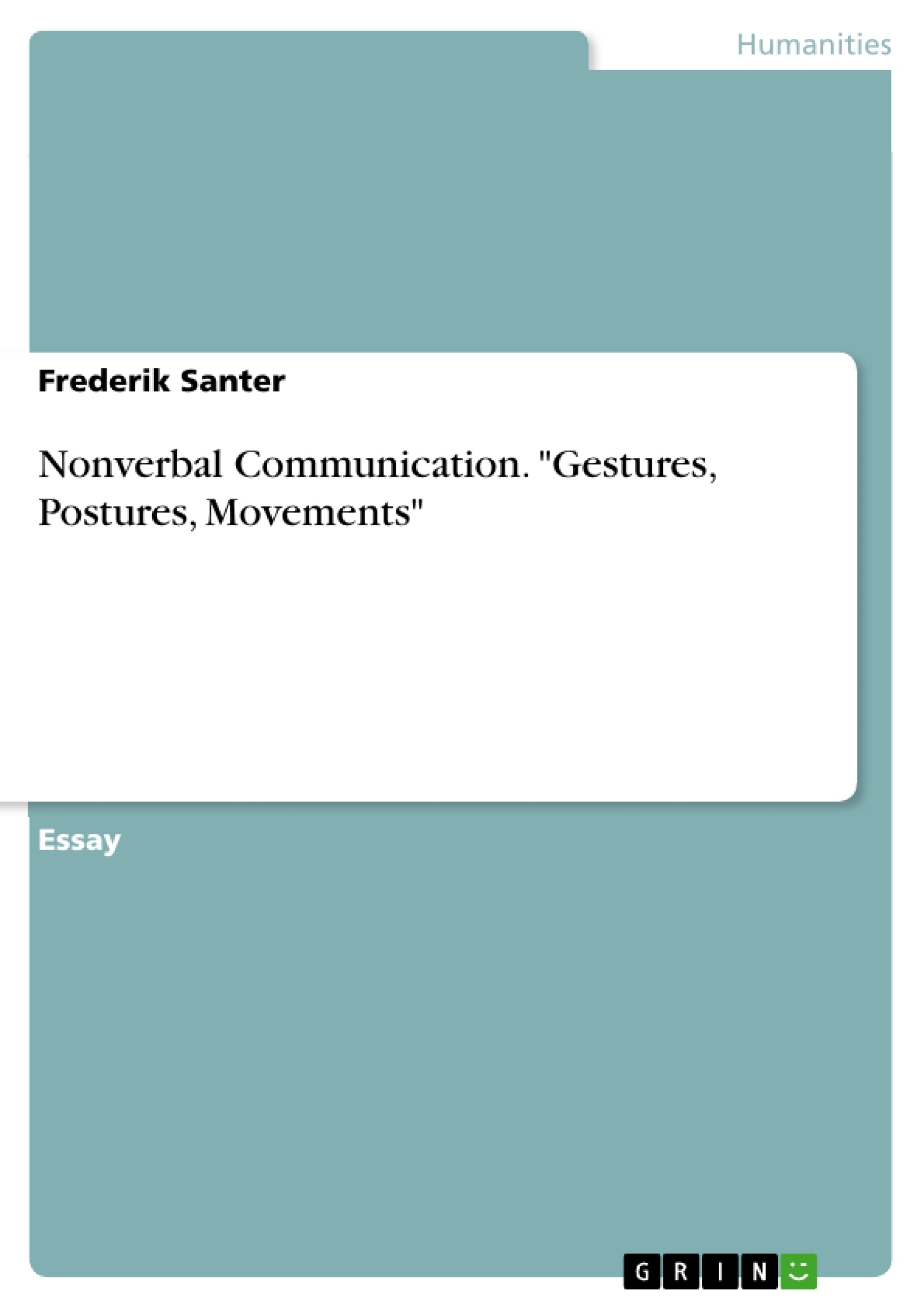This essay, accompanying a presentation that we held during the seminar „Nonverbal Communication“ at the University of Cologne, deals with the topic of nonverbal communication.
Nonverbal communication is the overall term for all forms of (human) communication which function without spoken words. Instead, carriers of meanings and messages may consist of gestures, postures, body movements, mimics, eye contact, touch, interpersonal distance, or other nonverbal expressions, e.g. laughing. The functions of nonverbal forms of communication may be the expression of emotions, the transmission of attitudes (e.g. a contemptuous facial expression may be used to express antipathy), the presentation of ones personal characteristics, or the complementation of a verbal message.
Table of Contents
- 1. Introduction
- 2. How do we perceive human (e)motion?
- 3. How are different emotions communicated?
- 4. The study „Nonverbal Channel Use in Communication of Emotion: How May Depend on Why“
- 5. Experiment 1 – Emotion production
- 6. Experiment 2 – Emotion Identification
- 7. Summary of the study
- 8. Literature
Objectives and Key Themes
This essay examines nonverbal communication, focusing on the conveyance of emotion through gestures, postures, and movements. It explores how humans perceive and interpret emotional expressions through visual cues and investigates the effectiveness of different nonverbal channels (body, face, and touch) in communicating specific emotions. The essay primarily analyzes a study by App, McIntosh, and Reed on nonverbal channel use in emotion communication.
- Nonverbal communication channels and their effectiveness in conveying emotion.
- The perception of human emotion through visual cues, such as body posture and movement.
- The role of nonverbal communication in expressing and interpreting various emotions.
- Analysis of a specific study on nonverbal communication of emotion.
- The relationship between nonverbal cues and the intention behind communication.
Chapter Summaries
1. Introduction: This introductory chapter defines nonverbal communication, distinguishing it from body language and encompassing various forms of communication such as paralanguage, haptics, proxemics, and environmental cues. It establishes the focus of the essay on nonverbal communication conveyed through body features (gestures, postures, and movements) and introduces the central study by App, McIntosh, and Reed which investigates how different nonverbal channels communicate emotion.
2. How do we perceive human (e)motion?: This chapter delves into the human capacity for perceiving and interpreting emotion through observation. It highlights the brain's mechanisms specialized for detecting human motion and the importance of visual cues such as body posture and movement in understanding emotional states. The chapter uses the example of point-light displays to illustrate how abstract representations of human movement allow observers to infer actions, identities, and even emotions. It further explains how body postures, whether sitting or standing, are crucial in conveying and interpreting emotions, with examples of postures indicating openness, relaxation, impatience, or attentiveness.
3. How are different emotions communicated?: This chapter addresses the adaptive significance of communicating emotions nonverbally. It underscores the importance of accurately understanding another person's emotional state and responding appropriately, noting that this capacity predates verbal communication. The chapter introduces the central premise that different nonverbal channels (face, body, touch) may be more effective at conveying certain emotions than others and sets the stage for the analysis of App et al.'s study on this very topic.
Keywords
Nonverbal communication, emotion perception, body language, gestures, postures, movements, visual cues, nonverbal channels (face, body, touch), emotion expression, point-light displays, App, McIntosh, Reed study.
Frequently Asked Questions: A Comprehensive Language Preview on Nonverbal Communication of Emotion
What is the main topic of this essay?
The essay focuses on nonverbal communication, specifically how emotions are conveyed and perceived through gestures, postures, and movements. It analyzes a study by App, McIntosh, and Reed examining the effectiveness of different nonverbal channels (body, face, and touch) in communicating various emotions.
What are the key themes explored in the essay?
Key themes include the effectiveness of different nonverbal communication channels in conveying emotion; the perception of human emotion through visual cues like body posture and movement; the role of nonverbal communication in expressing and interpreting emotions; an analysis of the App, McIntosh, and Reed study; and the relationship between nonverbal cues and communicative intent.
What nonverbal communication channels are discussed?
The essay discusses the face, body (including gestures and postures), and touch as primary nonverbal channels for conveying emotions. It also briefly mentions other forms like paralanguage, haptics, proxemics, and environmental cues within the broader definition of nonverbal communication.
How does the essay explore the perception of human emotion?
The essay explores the human capacity to perceive and interpret emotions through observation, highlighting the brain's mechanisms for detecting human motion and the importance of visual cues (body posture, movement). The concept of point-light displays is used to illustrate how even abstract representations of movement can convey emotion.
What is the significance of the App, McIntosh, and Reed study?
The study by App, McIntosh, and Reed is central to the essay. It investigates how different nonverbal channels (face, body, and touch) contribute to the communication of various emotions and provides empirical data analyzed within the essay.
What are the chapter summaries provided in the preview?
The preview offers summaries of each chapter: Chapter 1 introduces nonverbal communication and the central study; Chapter 2 discusses emotion perception through visual cues; Chapter 3 addresses how different emotions are communicated nonverbally; and subsequent chapters (4-7) delve into the study's methodology, results, and overall conclusions. Chapter 8 is dedicated to the literature cited.
What are the keywords associated with this essay?
Keywords include: Nonverbal communication, emotion perception, body language, gestures, postures, movements, visual cues, nonverbal channels (face, body, touch), emotion expression, point-light displays, App, McIntosh, Reed study.
What is the overall objective of the essay?
The essay aims to examine how humans perceive and communicate emotions nonverbally, focusing on the effectiveness of different communication channels and analyzing a specific research study on this topic.
- Quote paper
- Frederik Santer (Author), 2014, Nonverbal Communication. "Gestures, Postures, Movements", Munich, GRIN Verlag, https://www.grin.com/document/340056




